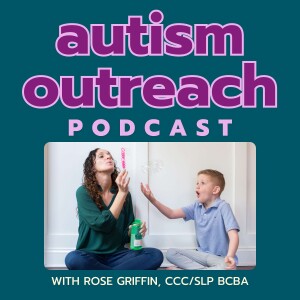
Autism Outreach - Easy Strategies For Parents and Professionals
Kids & Family:Parenting

Today, I am providing 15 strategies for SLPs working in an ABA setting. I have had the opportunity to work in ABA settings in addition to traditional schools. Whether you're new to the ABA world or thinking about taking a position in a specialized setting, these tips are some that I find so helpful for you, your colleagues, and your clients.
- Learn about your work setting: Understand your role and how it fits into the existing set up of the facility. Do not hesitate to ask the important questions!
- Build rapport with staff: Sometimes collaboration comes easy and sometimes it can be difficult. Get to know your team members and build relationships to facilitate working together.
- Learn about the science of Applied Behavior Analysis: Onboarding is going to differ from setting to setting, if it's new to you, it's important your facility is offering you proper training. I offer two courses with ABA Speech, Help Me Find My Voice and Start Communicating Today, that are great options.
- Learn about common assessments: If you're new to an ABA setting, understanding testing from the BCBA side can really change your approach to therapy. My favorite is the VB-MAPP but there are others.
- Provide information about speech therapy: Keep it positive and disseminate your goals and scientific approach. Always frame it with your client's best interest in mind.
- Feel comfortable with the jargon: There are so many words, you may or may not use them in conversation but you need to understand what you're talking about in a clinical setting.
- Think about creating shared goals: Once you understand the assessment, you can create goals with other teachers. The power of communication is incredible and it is important to collaborate and share goals across the setting.
- Embed communication across the learner's day: Communication takes place all day long, students can really flourish when they have more opportunity for practice and data is being tracked by all staff.
- Streamline your data collection: Many providers take data in all sorts of ways, when a student is working on a goal across settings, keep data collection in one place so that it is accessible and functional.
- Have access to your students' behavior plan (if applicable): Understand how to plan antecedently for students' unsafe or problem behavior. Make a copy and keep it on hand. Additionally, plan your environment accordingly, you want to feel comfortable serving all of your students.
- Collaborate: If there are other staff members who are going to be having a lot of time with your students, take the time to teach them about communication. These are the staff that are the most critical to building rapport with. You are the team!
- Think about parent communication: This communication is going to differ greatly in a specialized setting versus a traditional school. Stay in the loop of what is common practice for your facility and what parents need from you as far as communication goes.
- How are you providing service to students: Structure of therapy and instruction will differ depending on students needs. This can be pushing in, pulling out, one on one, and group therapy.
- The SLP and the BCBA ethical code both discuss collaboration: This is important, there are barriers, and I'm here to support you.
- Agree to disagree: We do not have to agree on everything but one thing we can agree on is, we want to help our students. Make decisions based on data.
If you're looking for more in depth information, you can check out my courses Help Me Find My Voice and Start Communicating Today. Also, be on the lookout in the coming months for my newest ASHA-approved course on SLPs in the ABA setting! I am also available for Discovery Calls if I can be of more service to you. See you next time!
#autism #speechtherapy
More Episodes
 2024-08-06
2024-08-06
 2024-07-16
2024-07-16
 2024-07-02
2024-07-02
Create your
podcast in
minutes
- Full-featured podcast site
- Unlimited storage and bandwidth
- Comprehensive podcast stats
- Distribute to Apple Podcasts, Spotify, and more
- Make money with your podcast
It is Free
- Privacy Policy
- Cookie Policy
- Terms of Use
- Consent Preferences
- Copyright © 2015-2024 Podbean.com





